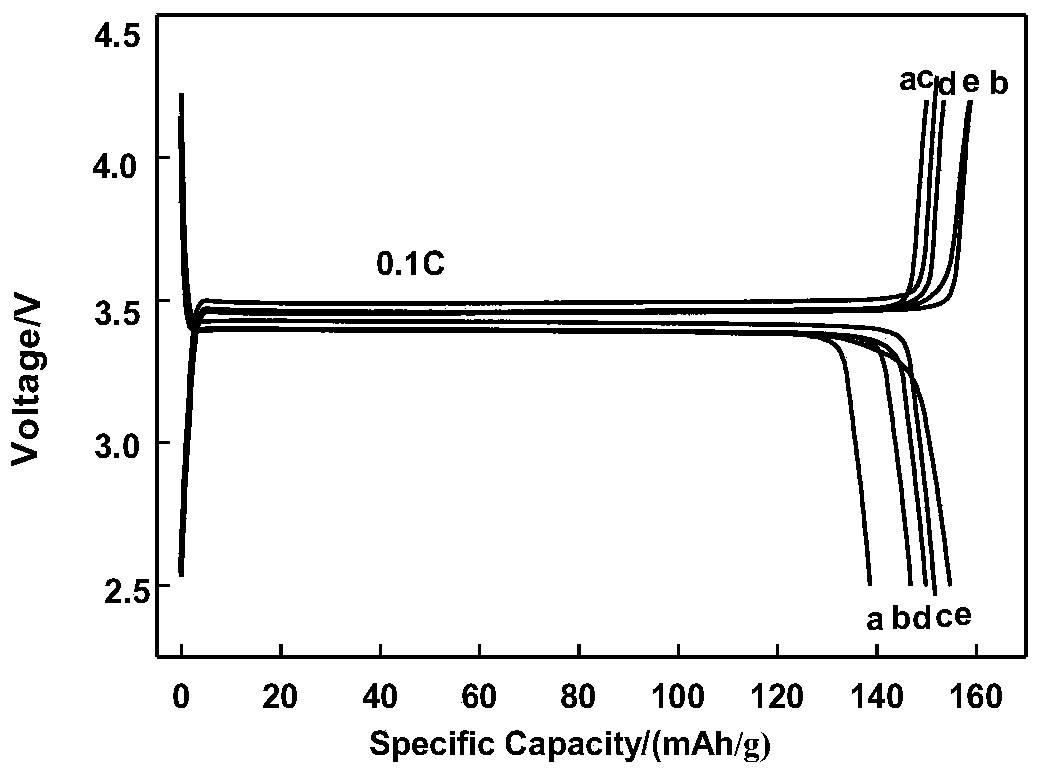A kind of spherical micronano iron phosphate/carbon composite material and preparation method thereof
A carbon composite material, micro-nano technology, applied in the field of lithium-ion batteries, can solve the problems of inconspicuous material modification, immaturity, uncontrollable mixing degree of reaction raw materials, etc.
- Summary
- Abstract
- Description
- Claims
- Application Information
AI Technical Summary
Problems solved by technology
Method used
Image
Examples
Embodiment 1
[0026] Weigh an equimolar amount of Fe(NO 3 ) 3 9H 2 O and H 3 PO 4 Prepare a 0.2mol / L mixed acid solution, measure a certain amount of ammonia water and dilute it to 0.5mol / L, and input the two in parallel and continuously into the crystallization reactor, the reaction temperature is 50°C, adjust and maintain the pH of the reaction system at about 2, The stirring intensity is 200r / s, and the reaction solution is naturally overflowed and discharged after the reactor is filled. After stirring and reacting for 10 hours, FePO is obtained after centrifugation, washing and drying. 4 ·xH 2 O powder. The precursor powder was heat-treated at 500 °C for 10 h to obtain nano-FePO 4 Precursor, nano-LiFePO prepared by carbothermal reduction method 4 / C cathode material. Weigh 12g of FePO 4 Precursor, 2.982g of Li 2 CO 3 Add 2.5g of sucrose and 5ml of deionized water to mix well, place in a tube furnace, feed high-purity nitrogen at 700°C for 16h, and obtain nano-LiFePO through h...
Embodiment 2
[0028] Weigh an equimolar amount of Fe(NO 3 ) 3 9H 2 O and H 3 PO 4 Make 0.2mol / L mixed acid solution, weigh FePO 4 After the polyacrylamide with a theoretical mass of 0.5wt% is dissolved in the acid solution, measure a certain amount of ammonia water and dilute it to 0.5mol / L, and input the two in parallel and continuously into the controlled crystallization reactor. The reaction temperature is 50°C, adjust and maintain the temperature of the reaction system. The pH is around 2, the stirring intensity is controlled to 200r / s, the reaction solution is naturally overflowed and discharged after the reactor is filled, and after stirring for 10 hours, it is centrifuged, washed and dried to obtain 0.5wt% PAM-FePO 4 ·xH 2 O powder. The precursor powder was heat-treated at 500 °C for 10 h to obtain PAM-FePO 4 Precursor, prepare the nanometer LiFePO that adopts PAM modification by the method for embodiment 1 4 / C cathode material. Such as figure 1 Shown, the obtained PAM-FeP...
Embodiment 3
[0030] Weigh an equimolar amount of Fe(NO 3 )3 9H 2 O and H 3 PO 4 Make 0.2mol / L mixed acid solution, weigh FePO 4 After the soluble starch with a theoretical mass of 0.5wt% is dissolved in the acid solution, measure a certain amount of ammonia water and dilute it to 0.5mol / L, and input the two in parallel and continuously into the controlled crystallization reactor. The reaction temperature is 50°C, and the pH of the reaction system is adjusted and maintained. At about 2, the stirring intensity is controlled to 200r / s, and the reaction solution is naturally overflowed and discharged after the reactor is filled. After stirring for 1 hour, it is centrifuged, washed and dried to obtain 0.5wt% soluble starch-FePO 4 ·xH 2 O powder. The precursor powder was heat-treated at 600 °C for 10 h to obtain spherical micro-nano FePO 4 Precursor, according to the method of embodiment 1, prepare the micronano LiFePO that adopts soluble starch modification 4 / C cathode material. Such a...
PUM
 Login to View More
Login to View More Abstract
Description
Claims
Application Information
 Login to View More
Login to View More - Generate Ideas
- Intellectual Property
- Life Sciences
- Materials
- Tech Scout
- Unparalleled Data Quality
- Higher Quality Content
- 60% Fewer Hallucinations
Browse by: Latest US Patents, China's latest patents, Technical Efficacy Thesaurus, Application Domain, Technology Topic, Popular Technical Reports.
© 2025 PatSnap. All rights reserved.Legal|Privacy policy|Modern Slavery Act Transparency Statement|Sitemap|About US| Contact US: help@patsnap.com


